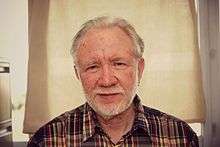David Lorenzen
David N. Lorenzen is a scholar of religious studies, author, and professor of South Asian History at the Centre for Asian and African studies, El Colegio de México.[1][2][3][4]
 David Lorenzen as a professor and researcher at El Colegio de México | |
| Affiliation | El Colegio de México |
|---|---|
| Location | Mexico City |
He is chiefly notable for publishing several essays and books on ancient, medieval, and modern periods in South Asian history and religion, especially on Hinduism and Missionaries in India, namely, Who invented Hinduism?, Bhakti Religion in North India, The Scourge Of The Mission: Marco della Tomba in Hindustan, and many more.[1][2][3][5]
Education
David N. Lorenzen received his doctorate in the History of Indian Religions from the Australian National University in 1968 where he studied with the historian A. L. Basham (Arthur Llewellyn Basham). Before that he was in India on a Junior Fellowship from the American Institute of Indian Studies (1965-1966), studied ancient Indian history at the School of Oriental and African Studies of the University of London (1962-1965), and did his undergraduate studies at Wesleyan University (Connecticut).
Academic career
Lorenzen was a professor and researcher in the Center for Asian and African Studies at El Colegio de México (El Colegio de México) from 1970 to 2010. Since 2011 he has been professor of the Interdisciplinary Studies Program at the same institution. He served as editor of the Asia and Africa Studies Journal de from 1987 to 1991 and has been a member of the editorial committee since 1970.
Lorenzen has been visiting professor at the University of Iowa (Iowa City), Harvard University, the École des Hautes Études (Paris) and La Università Sapienza (Rome). He has presented papers at many academic conferences in various countries. Since 1984 he has been a member and then emeritus member of the National System of Researchers of the Mexican government. He has received research grants from the American Institute of Indian Studies, the Social Science Research Council, and the Indian government.
Work
The academic research of David Lorenzen has concentrated mainly on the history of Hindu and Christian religious movements in India, but he has also worked on aspects of Indian political history and literature. He has published translations into both Spanish and English of texts written in Hindi and Sanskrit. The topics of his publications include bhakti religious movements, Kabir and his followers, the Naths, the Kapalikas, the Kalamukhas, and Capuchin missionaries in India. He has also written about the life of Shankaracharya, the history of the Gupta Empire, and the conceptualization of Hinduism in pre-colonial and colonial India.
Lorenzen has edited and reviewed essays published on notable journals and books.[1][2][6][7]
- The Kāpālikas and Kālāmukhas: two lost Śaivite sects (1972)
- Kabir legends and Ananta-das's Kabir Parachai (1991)
- Praises to a formless god: Nirguṇī texts from North India (1996)
- Who invented Hinduism: essays on religion in History (2006)
- The Scourge Of The Mission: Marco della Tomba in Hindustan (2010)
- A Dialogue Between a Christian and a Hindu About Religion by Giuseppe Maria da Gargnano (2015)
- Religious Movements in South Asia 600-1800
- Bhakti Religion in North India: Community Identity and Political Action
- Yogi Heroes and Poets: Histories and Legends of the Naths
- Religious change and cultural domination: XXX International Congress of Human Sciences in Asia and North Africa
- Studies on Asia and Africa from Latin America
- Nirgun Santon Ke Swapana
- Atadura y liberación (Estudios De Asia Y Africa) (Spanish Edition)
- Myths of the Dog-Man. (book reviews): An article from: The Journal of the American Oriental Society
- History and Historiography of the Age of Harsha. (book reviews): An article from: The Journal of the American Oriental Society
- Historical Dictionary of Sikhism.(Review): An article from: The Journal of the American Oriental Society
- A Catalog Of Manuscripts In The Kabir Chaura Monastery, Expanded Edition
References
- Lorenzen, David N. (2006). Who invented Hinduism: essays on religion in History. Yoda Press. ISBN 978-81-02-27261-7. Retrieved March 17, 2012.
Ten masterly essays on the history of religious moments and ideologies by in India by eminent scholar of religious studies, David N. Lorenzen
- Rajan Gurukkal (May 5, 2009). "Essays on religion, power, community". Chennai, India: hindu.com. Retrieved March 19, 2012.
- "The scourge of the mission: Marco Della Tomba in Hindustan (Yoda, Rs 350) by David N. Lorenzen". Calcutta, India: telegraphindia.com. January 28, 2011. Retrieved 19 March 2012.
The author has "filled out" autobiographical essays and letters written by Della Tomba himself.
- "David N. Lorenzen (El Colegio de Mexico)". columbia.edu. Retrieved March 20, 2012.
Professor David N. Lorenzen - El Colegio de Mexico, CEAA
- "The Scourge Of The Mission: Marco della Tomba in Hindustan - David N. Lorenzen". yodapress.com. Retrieved March 18, 2012.
David N. Lorenzen is Professor of South Asian History at the Center for Asian and African Studies, El Colegio de Mexico
- "The Origins and Development of Classical Hinduism". The Journal of Asian Studies. journals.cambridge.org. 49 (02): 424–425. doi:10.2307/2057356. Retrieved March 19, 2012.
- "Aspects of Political Ideas and Institutions in Ancient India". The Journal of Asian Studies. journals.cambridge.org. 29 (01): 197–198. doi:10.2307/2942575. Retrieved March 19, 2012.
External links
- David Lorenzen profile on Centro de Estudios de Asia y África website
- Profile on Academia